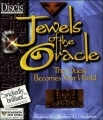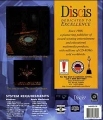Jewels of the Oracle
First posted on 30 October 1997. Last updated on 07 September 2009.

|
| The eerie atmosphere compliments well a lonely journey. |

|
| The Oracle's 24 brainteasers range from the complex to the tedious. |

|
| The animation brings the puzzles alive. |
Jewels of the Oracle is a niche title for gamers who simply enjoy challenging logic puzzles or games of strategy. Its success is seen from the fact that several imitators have since been released from different developers and publishers, all claiming to be the true sequel to the cult classic Jewels of the Oracle. For the veteran adventure gamers, however, such enthusiasm quickly dies down from the lack of continuity in gameplay between these puzzles.
Only one legacy remains of the civilization known throughout the Fertile Crescent before the Sumerians. People of extraordinary intellect, their pursuits were of the mind instead of conquering and fighting. They built a secret complex to train and practice their skills of logic and reason. Using technologies and ancient magic long since forgotten, they constructed devices of incredible ingenuity. Those who entered the domain of the Oracle and resolved all the tasks set before them went on to greatness. Those who failed... were lost forever. This structure, lost to the archeological record, has been sought for millennia but never found... until now. You, a supplicant who seeks admission to this lost city, must solve each puzzle laid down by the ancients in the 24 rooms of the domain. Guided by the Oracle, a jewel is rewarded for every success in resolving these tasks. When all the jewels are recovered and placed on the altar in the Oracle Room, the entrance to the lost civilization of the ancients will finally be revealed.
ELOI Production heads the difficult task of creating a story theme that ties the various puzzles together. Whether such an attempt is a success here is debatable. Regardless, the elaborate story put forward in attempt to explain the origins of these puzzles is admired. All the puzzles in Jewels of the Oracle are fully animated; that is, an animation is played for each move the player makes in manipulating a puzzle. Both the graphics and the animations are breathtaking to watch. They capture well the eerie mystique of an ancient civilization left behind. Movements between different locations are also fully animated. Ambient sound effect and music fill the player's ears to further enhance the immersing experience. Macromedia is used to construct the game interface. Video animations are compressed with Apple QuickTime for Windows.
The game has 24 puzzles in total. Some are logic based and some are games of strategy. There is no time limit set for each puzzle. The Well Room acts as a central hub that directs the player as to which puzzles are available to be solved at any given time. The puzzles vary greatly in the level of difficulty. Some puzzles are extraordinarily hard. The game is controlled using a point and click single button mouse. A context sensitive cursor shows the player directions of navigation as well as which objects can be manipulated in the puzzles. The latter function is important because there is no instruction given as to both the rules and objectives of these puzzles. In any given puzzle, the player needs to experiment by touching each piece of the puzzle to see how it reacts. With the power of observation, the player eventually deduces a set of rules used to solve the puzzle. At the beginning of each attempt, the Oracle recites a series of cryptic messages as small clues to the puzzle ahead. A jewel is awarded for solving a puzzle. A less valuable jewel is also given if the player declines a particular puzzle. The ending of the game differs depending on the type of jewels collected.
There is no doubt that the ravishing graphics and animations may catch the eyes of many gamers to the point that many will spend countless hours dwelling on a single puzzle which otherwise may have long been abandoned. Part of the appeal also is that the player must figure out the objectives and the rules of these puzzles. These moments of enlightenment are the fixes that many gamers so desperately pursuit. Many of the puzzles are original and not just rehashes of known classics. Some of the puzzles have multiple solutions. Most require strategy rather than brute force. As some of the puzzles are set up randomly, they play differently each time the puzzle is restarted. For gamers who are anxious to get to the puzzles, a "Shaman Mode" can turn off all video transitions between the scenes. This mode can also be used to lessen the hardware burden when playing the video. All the graphics are pre-rendered in 640x480x256 color mode. Subtitling is available. There is no limit to the number of saved games. An option is available for the player to decline a difficult puzzle in order to move on with the game. Two possible endings to the game exist, depending on whether or not the player has completed all the puzzles.
Jewels of the Oracle has a number of significant drawbacks. It is not surprising that in this type of game design the story merely serves as a superficial backdrop for the placement of the puzzles. Not only the puzzles stand isolated from the story, they also stand isolated from each other. The clues given by the Oracle are utterly useless. The game has minimal replay value once the puzzles are solved. Furthermore, the beautiful graphics and animations eventually lose their appeal. The slow animations of the puzzles place unnecessary delay on the impatient gamer. For all the effort the player puts into this game, the ending is far too short and uninspiring. It simply shows a small video clip of the player's entrance into the deserted city, with the ability to only look around in a 360° direction but not move elsewhere. In fact, it leaves the player puzzling as to the whole point of the story that has been so elaborately created.
Care must be taken when installing this game in Windows 95. The game automatically overwrites key drivers and files in order to install its own version of QuickTime in the WindowsSystem directory, even if a later version has already been installed. This can cause the dreaded missing or conflicting .dll dynamic link library error. This error can also occur when installed in Windows 3.x if there is already a version of QuickTime installed prior.
The game is originally distributed by Discis Entertainment. In 1997, Discis Entertainment ceases operation for financial reasons and the publisher is changed to DreamCatcher Interactive. A patch is available from DreamCatcher Interactive for the original release to improve Windows 95 compatibility. The two releases are identical otherwise. For a rather simple game in design, Jewels of the Oracle is quite hardware intensive. Loading times between scenes can be an annoyance for players who are hardware challenged. Pretty graphics may keep some gamers up many nights until the game is finished, but Jewels of the Oracle loses its appeal quickly once the player gets pass through the eye candy.

